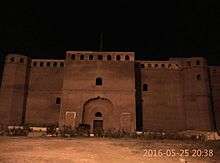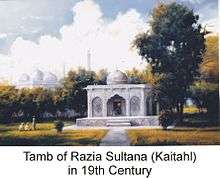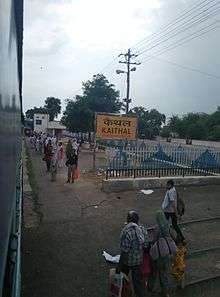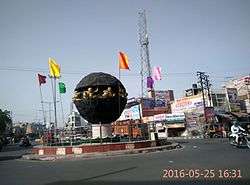Kaithal
| Kaithal कैथल Kapisthal | |
|---|---|
|
Pehowa Chowk, Kaithal | |
  Location in Haryana, India | |
| Coordinates: 29°48′N 76°23′E / 29.8°N 76.38°ECoordinates: 29°48′N 76°23′E / 29.8°N 76.38°E | |
| Country |
|
| State | Haryana |
| District | Kaithal |
| Named for | Hanuman |
| Government | |
| • Member of Parliament | Raj Kumar Saini |
| • Member of the Legislative Assembly | Randeep Singh Surjewala |
| Elevation | 250 m (820 ft) |
| Population (2011)[1] | |
| • Total | 144,915 |
| Languages | |
| • Official | Hindi |
| Time zone | IST (UTC+5:30) |
| PIN | 136027 |
| Telephone code | 01746 |
| Vehicle registration | HR-08,HR-64(for commercial vehicles) |
| Sex ratio | 880 ♂/♀ |
| Lok Sabha constituency | Kurukshetra |
| Website |
kaithal |
Kaithal (Hindi: कैथल) is a city and a municipal council in Kaithal district in the Indian state of Haryana. Kaithal was previously a part of Karnal District and later, Kurukshetra District until 1 November 1989, when it became the headquarters of the Kaithal District of Haryana. Kaithal shares common boundary with Patiala (Punjab), Kurukshetra, Jind and Karnal. Kaithal district is situated in the North-West of the Haryana state. Its North-West boundaries which include Guhla-Cheeka is attached to Punjab State.
Geography
Kaithal is located at 29°48′N 76°23′E / 29.8°N 76.38°E.[2] It has an average elevation of 220 metres (721 feet).
Mythology/Pre-History

Historically, it was known as Kapisthal, meaning "Abode of Kapi", another name of Lord Hanuman, and it is said to have been founded by the Pandava Emperor, Yudhishthira of Mahabharata. It is traditionally connected with Hanuman, and has a temple dedicated to [[Añjanā |Anjani]], the mother of Hanuman. It is also said that it is the birthplace of Lord Hanuman and there is a temple constructed at that place known as "Anjani Tila" among the residents of Kaithal.
The Vridhakedara (Vidkyar) sanctum of Kaithal finds a mention in Vedic texts of Vaman Puran.[3]
Kaithal, with many of its temples, is also an important milestone in 48 Kos Parikrama pilgrimage.
History
Timur stopped here in 1398, before attacking Delhi. Later, the city became a Muslim cultural centre, under the rule of Delhi Sultanate. Tombs of several Sufi saints dating from the 13th century can be found in the city today; most important among them is that of Sheikh Sala -ud-din of Bhalkh (1246 CE). The town was renovated and a fort was built during the rule of the Mughal Emperor, Akbar, and as per Ain-i-Akbari, it was a pargana, under the sarkar of Sirhind, and had developed into an agricultural centre [4]
Razia Sultana, the first woman ruler of India, reigned as the Sultana of Delhi Sultanate from 1236 to 1240. She fled Delhi with Malik Altúniya after they were defeated on the 24th of Rabí'u-l awwal A.H. 638 (Oct. 1240), and reached Kaithal the next day, where their remaining forces abandoned them, and they both fell into the hands of the Hindus and were killed on Nov. 13, 1240.[5][6][7] Tomb of Rajia Begam is still found here. This aspect is still not well known outside Kaithal, but residents know about the mazaar of Razia Begum even generations later.
Sikh rule in Kaithal
In 1767, it fell into the hands of the Sikh chieftain, Bhai Desu Singh (d. 1781), who led a large Sikh force from his native village of Bhucho, In the Punjab. whose descendants, the bhais of Kaithal, ranked among the most powerful Cis-Sutlej states. The Sikh Chieftains of Kaithal, ruled from 1767 until Its fall, In 1843. By 1808, It came under British Influence. The state was ruled by the Scindhia dynasty of the Maratha Empire and paid tributes to the Marathas, until the Second Anglo-Maratha War of 1803-1805, after which the Marathas lost this territory to the British.[8][9][10] Bhai Udey Singh ruled over Kaithal and proved as the last King. Bhai Udey Singh died on 14 March 1843. It became a municipality in 1867. In 1901, the town had a population of 14,408 and was the tehsil in the district of Karnal. The fort of the Bhais is still extant, and their title Bhai became common with the primary Sikh rulers. Peoples of Kaithal took active part in freedom struggle in 1857.[11][12][13]
Demographics
As of the 2011 India census, Total population of Kaithal is 9,45,631.[1] The sex ratio is 887 (F/M) and 11.5% of the population is under six years of age. The effective literacy rate is 80.76%; male literacy is 87.65% and female literacy is 73.07%. Punjabi & Hindi are major languages. There are 277 villages and 253 Punchayats in Kaithal districts. Kaithal district consists of two sub-divisions two tehsils namely Kaithal & Guhla & five sub-tehsils namely Pundri, Rajaund, Dhand, Kalayat and Siwan. The name of Kaithal, Pundri, Pharal, Siwan and Kalayat show that the soil of Kaithal has been religious and cultural rich heritage.
Landmarks
Kaithal Fort


There exist remains of the fort of the Bhais, and several Muslim tombs of the 13th century and later. The Kaithal fort has many gates made by British rulers and used to control the entry of trade goods and other items.
As on 2016, the fort has now been restored and renovated (as seen in pictures). It now forms one of the most visible and importamnt landmarks of Kaithal.
Tomb of Razia Sultana

Tomb of Razia Sultana, who gained the throne of Delhi Sultanate under the Mamluk Sultanate, is situated 10 km north-west of the Kaithal city in Siwan on Kaithal-Cheeka-Patialaroad. It is close to the jail constructed nearby by the present administration. She and her husband Malik Altunia who was the governor of Bhatinda (Punjab) were decapitated by the local Jat people of area. It is speculated that she might have been disinterred form Kaithal and then reburied at her Delhi's tomb.
Raziya al-Din (1205 in Budaun – October 13, 1240), throne name Jalâlat ud-Dîn Raziyâ, usually referred to in history as Razia Sultana, was the Sultan of Delhi in India from 1236 to May 1240. Like some other Muslim princesses of the time, she was trained to lead armies and administer kingdoms if necessary.[15] Razia Sultan was the only woman ruler of both the Sultanate and the Mughal period, although other women ruled from behind the scenes.[16] Razia refused to be addressed as Sultana because it meant "wife or consort of a Sultan". She would answer only to the title "Sultan."[17]
One of the highest flag of India
In Kaithal a 22-by-14.6-metre (72 by 48 ft) national flag is hoisted 63 metres (207 ft) above the ground in Hanuman Vatika.
48 Kos Temples
Following two pilgrimage points of Kaithal town form part of Kurukshetra's 48 kos pariktrama.
Vidkyar Teerth (Vriddh Kedaar)
Vriddh Kedaar or Vidkyaar as it is popularly known is an important religious place for Hindus. This is one of the several piligrimages in 48 kos parikrama of Kurukshetra. This pilgrimage has been mentioned in ancient text of Vamana Purana also.
Vaman Purana says :
"Kapisthaleti vikhyatam sarvapatakanashanam yasmina sthitaha swayam devovridha kedara samgjijitaha" (2)
(Translation: The destroyer of all devilish deeds, the famous Kapisthala sanctum is here because Lord Vridhakedara himself resides in it.)
The Vridhakedara sanctum changed to "Vidkyara" as a result of the philological principle of "mukhasukha", or ease of speaking.[3]
Shree Gyarah Rudri Mandir
It is one of the famous temple of city, where divine eleven Rudra were placed before 5000s years ago and the temple is known for its art, architecture, beautiful scriptures and large area, a big statue of hanumaan compliments the beauty of this temple.
Other Religious places
Anjani Teela

Anjani was the name of mother of lord Hanuman. Kaithal was earlier as Kapisthal, the abode of monkeys (or monkey God, Hanuman).
Other Temples
- Badi Devi Mandir- It is one of the oldest temples in kaithal,
- Sanatan Dharam mandir and vridh Asharam- This is also one of the oldest temples of the city, situated at quality chownk, this temple is famous for beautiful large idol of "kali mata" and a nav graha and shani mandir and nav devi temple where art, scriptures, painting reflects a considerable an artistic influence.* Hanumaan Mandir - Situated in heart of the city at Jattan Moh.
- Geeta Bhawan Mandir
- Dera Baba Shital Puri
- Kutti Shiv Mandir and Deva Ka Mandir (a.k.a. Guffa Wala Mandir) at Mata Gate.
- Hanumaan Vatika, a big park, located near New Bus Stand, which has large Hanumaan statue and a beautiful temple.
Gurudwaras
- Gurudwara Neem Sahib - This Gurudwara is located at the Dogra gate, near Sivan Gate on the Cheeka Pehowa Road, Kaithal.
- This Gurudwara is dedicated to the Ninth Guru, Guru Tegh Bahadur Ji. He stopped here on his way from Anandpur Sahib to Delhi. Guruji stayed at the site of Gurudwara Manji Sahib. Early in the morning, Guruji came to this place. After taking a bath at the Thandar Tirth (also referred to as the Dandhar Tirth), Guru sat in meditation under a neem tree at this place. A large congregation of people who had heard of the Guru's arrival gathered there. One amongst them suffered from high fever. Guruji gave him the leaves of the neem tree and he was cured. This place then came to be known as Neem Sahib. All gurpurabs are celebrated here. A langar is organized every month on Sangrand (the first day of the month in the lunar calendar). A local committee appointed by the Shiromani Gurdwara Prabhandhak Committee looks after the management of the Gurudwara.[18]
- Gurudwara Topiyon Wala - Situated in the middle of the city, this is the only Gurudwara/Temple where Guru Granth Sahib & Ramayan are recited together—a unique combination of Sikhism & Hinduism.
- Gurudwara Manji Sahib - Gurdwara Manji Sahib is situated in Sethan Mohalla, near Hind Cinema. It is very near to the Gita Bhavan.
- This Gurudwara is dedicated to the Ninth Guru, Guru Tegh Bahadur. Guru Tegh Bahadur, after emancipating the sangat of the Malwa region, arrived here from Baher. The Guru told a carpenter from Bahir, named Malla, that he wanted to go to Kaithal and asked if there was any Sikh devotee there. Malla replied that there were two houses belonging to Banias and one to a Sikh there. On reaching Kaithal, Malla asked Guru whose house he would like to go to first. Guru replied the one that is nearest. Malla took Guru to the house o f a fellow carpenter, also named Malla, who served the Guru with great devotion. Pleased with his devotion, the Guru told him to light a lamp for 40 days in honor of the Guru's darbar and he would be blessed with a son. The carpenter was blessed with a son in due course and he donated this place to the Gurudwara. On the request of the banias, Guru visited their house for lunch. He blessed the spot by saying that kirtan (singing of devotional songs) would be the norm here. This is the site of the Gurudwaras Manji Sahib. Guru spent three days preaching the tenets of Sikhism here and then left for village Barne. The birth anniversaries of Guru Nanak Dev and Guru Gobind Singh are celebrated with great fervour here.[18]
- Gurudwara Shri Patshahi Chevin Ate Nauvin Sahib - This Gurudwara is situated in the Village Cheeka, Kaithal. Cheeka is situated on the Patiala Kaithal Road. Guru Har Gobind and Guru Tegh Bahadur came here. Guru Tegh Bahadur came here while going to Gurudwara Nanak Mata Sahib, When Guru was in Darolli Bhai, He received message from Baba Gurditta,s Disciple Baba Almast that Sadhus had captured Gurudwara Nanakmata and renamed it as Gorakh Mata. So going towards Gurudwara Nanakmata sahib via Kurukshetra Guru came here.
- Guru Tegh Bahadur ji came here while he was going to Delhi. When Kashmiri Pandits came to Guru in Anandpur Sahib and requested to save them from Aurangzeb. Accepting there request Guru to sacrifice his life to save them Guru while going to Delhi Via Patiala, GURU came here to Bhai Galora Masand. He was Jathedar of Hansi to Hisar. There were follower along with Guru. Who wanted to come along with Guru to Delhi but Guru stopped them and asked them to go back. Followers requested that they will not be able to live without them. Then Guru Tegh Bahadur told them visiting this place will give them result of having darshan of Guru Tegh Bahadur. It is believed that who so ever will visit this place with devotions his/her wishes will be fulfilled.[19]
- Gurudwara Sahib - This Gurudwara is situated in Nand Singh Wala village, Kaithal. This village is located at Punjab border.[20]
Islamic religious places

- Tomb of Sheikh Tayyab : The 16th century tomb is situated in Kaithal city near Railway line. The words 'Sheikh' and Tayyab' stand for terms 'Fakir' (saint) and 'pure' Sufi saint Hazrat Shah Kamal came to Kaithal from Bagdad. Sheikh Tayyab was a disciple and khalifa of Baba Shah Kamal. Sheikh Tayyab died sometime in the late 16th century AD. It is said that this tomb was constructed by Hazrat Shah Sikandar , the grand son of Hazrat Shah Kamal. The tomb is built on a square plan, a popular style of Pathan architecture. The roof is surmounted by a bulbous dome and a lotus flower finial rests on an octagonal drum-base.Mazar of Hazrat Shah Sikandar Qadri Kaithaly
Sheikh Tayyab actual name was Lala Maidni Mal and he was one of the advisor to Mughal Emperor Akbar. He converted to Islam at the hands of Hazrat Shah Kamal Qadri. His descendants from Hindu wife are called "Qanugo" and the place where they used to live is called Mohalla "Qanugoyan" in Kaithal. There was a tradition when some one from Qanugo used to get married, they used to send one pitcher of sweet drink (sherbat) to sheikh Tayyab masjid (also known as masjid of mirrors)

and one pitcher to Hazrat baba shah Kamal shrine.
- Tomb of Hazrat Shah Kamal Qadri and Hazrat Shah Sikandar Qadri (Baba Shah Kamal Lal Dayal): known as Peer Baba to visitors, situated near Gol Market. Hazrat Shah Kamal Qadri’s shrine is well known in sub-continent for the past 450 years.He came from Baghdad in the time of Mughal emperor Akbar.[21]Mazar of Baba Shah Kamal Qadri Kaithaly
Once there was famine in the times of Hazrat shah kamal. When he came to know about it, he asked to prepare Two big pots of special food (Dalya). One was prepared by a Muslim and the other one was prepared by a Hindu brahman. It was announced that people from all over the city can come and eat day and night and take away this Dalya to their homes as well. There was a miracle that despite thousands of people eating from this langar, big pots were still filled with food. When famine ended, this food was also discontinued.
After that incident, it was a tradition that every year in the month of "sawan" rainy season, on all four Thursdays of rainy season, people of every religion used to get this special food "dalya" prepared and send it to the dargah of baba shah kamal to be distributed among the needful.
Dharamshalas
- Saini Dharamsala - This Dharamshala is located near Ashok Cinema road, Kaithal. This Dharamsala is taken care by Saini community.
- Panchal Dharamsala - This Dharamshala is located on peoda road, near Kaithal Gas Agency, Kaithal. This dharamsala is taken care by Panchal community. Which has a statue of Vishavkarma.
- Ravidass Mandir, Partap Gate kaithal.
Transport

The city is connected to the state capital Chandigarh through National Highway 65. The city had a rail connection to Kurukshetra and Narwana which further went to Jind (local trains only) until 2014, when government started a rail service between Delhi and Kurukshetra via Kaithal. The move for this service was initiated and pushed by the Previous Member of Parliament from Kurukshetra, Naveen Jindal with an aim to give people a convenient mode of transport to reach the capital. Earlier they had to board trains at the Kurukshetra railway station.[22] In 2015, a new express train connecting Chandigarh and Jaipur via Kaithal has been started.
Educational Institutions
- sunshine public school , kaithal
- Indira Gandhi Public School
- Indus Public School, Kaithal
- O.S.D.A.V Public School, Kaithal
- R.K.S.D PUBLIC SCHOOL[23]
Notable People
- Om Prabha Jain
- Randeep Surjewala
- Yash Pal, Renowned Scientist
- Chirag Khurana
- Jai Parkash
- Rahul Singh (cricketer)
See also
- Haryana Tourism
- List of Monuments of National Importance in Haryana
- List of State Protected Monuments in Haryana
- List of Indus Valley Civilization sites in Haryana
- List of National Parks & Wildlife Sanctuaries of Haryana, India
| Wikimedia Commons has media related to Kaithal. |
References
- 1 2 Official Website kaithal.gov.in- Introduction Kaithal
- ↑ Falling Rain Genomics, Inc - Kaithal
- 1 2 kaithal.nic.in/
- ↑ Sarkar of Sirhind - Kethal (Kaithal) Ain-i-Akbari.
- ↑ Introduction
- ↑ Razia Sultan The History of India, as Told by Its Own Historians. The Muhammadan Period, 1867-1877.
- ↑ Razia Sultan Tomb
- ↑ A Comprehensive History of Medieval India: From Twelfth to the Mid ... - Farooqui Salma Ahmed, Salma Ahmed Farooqui - Google Books. Books.google.co.in. Retrieved 2012-05-26.
- ↑ History Of The Marathas - R.S. Chaurasia - Google Books. Books.google.co.in. Retrieved 2012-05-26.
- ↑ https://books.google.com/books?id=Nyk6oA2nOlgC&pg=PA379&lpg=PA379&dq=%22second+anglo+maratha+war%22+sutlej&source=bl&ots=XGHcTeQC7h&sig=tGnkkkS6o63cT5mX-pIv7R9PtsQ&hl=en&sa=X&ei=DmvDT-HOKcHWrQfj2LjhCQ&ved=0CFYQ6AEwBw#v=onepage&q=%22second%20anglo%20maratha%20war%22%20sutlej&f=false
- ↑ Sharma, Suresh K (2006). Haryana: Past and Present. Mittal Publications. p. 144. ISBN 81-8324-046-1.
- ↑ Hoiberg, Dale; Indu Ramchandani (2000). Students' Britannica India. Popular Prakashan. p. 161. ISBN 0-85229-760-2.
- ↑ Kaithal Town The Imperial Gazetteer of India, 1909, v. 14, p. 288-289.
- ↑ http://www.census2011.co.in/census/city/35-kaithal.html
- ↑ Gloria Steinem (Introduction), Herstory: Women Who Changed the World, eds. Deborah G. Ohrn and Ruth Ashby, Viking, (1995) p. 34-36. ISBN 978-0670854349 Archived August 27, 2009, at the Wayback Machine.
- ↑ Table of Delhi Kings: Muazzi Slave King The Imperial Gazetteer of India, 1909, v. 2, p. 368..
- ↑ O’Brien, Derek. Derek Introduces: 100 Iconic Indians. Rupa Publications. ISBN 8129134136.
- 1 2 http://www.historicalgurudwaras.com/India/Haryana/Kaithal/Kaithal.php
- ↑ http://www.historicalgurudwaras.com/India/Haryana/Kaithal/GurudwaraShriPatshahiShevinateNauvin/gallery.php
- ↑ http://www.facebook.com/nandsinghwalakaithal/info
- ↑ http://www.shah-kamal.com
- ↑ "Delhi-Kaithal train from this year". The Hindu. 2013-02-27. Retrieved 9 March 2014.
- ↑ http://rksdpublicschool.org/
External links
-
 Chisholm, Hugh, ed. (1911). "Kaithal". Encyclopædia Britannica. 15 (11th ed.). Cambridge University Press.
Chisholm, Hugh, ed. (1911). "Kaithal". Encyclopædia Britannica. 15 (11th ed.). Cambridge University Press. - "Razia Sultan Tomb".
- "History of Kaithal".
- "Kaithal district, official website".
